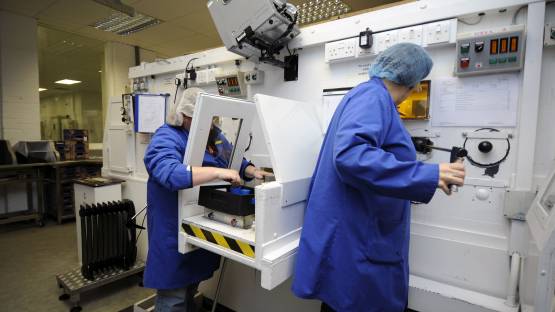
Schematics of Lutetium-177 radiopharmaceutical design, a key radionuclide in cancer therapy.
New promising tumour cell specific as well as tumour microenvironment specific targets continue to be identified, and diverse types of high affinity carrier molecules for such targets are under nonclinical and/or clinical evaluation after radiolabeling with 177Lu. Today, there are around 180 ongoing clinical trials based on 177Lu labelled molecules. Targets currently being pursued for radiotherapeutic development include different inhibitors of prostate-specific membrane antigen (PSMA) and fibroblast activation protein (FAP), derivatives of neurotensin, chemokine receptor CXCR4 and carbonic anhydrase 9 (CAIX).
Developments in 177Lu-based radiotherapeutics has recently transformed treatment management of neuroendocrine tumours and prostate cancers to a larger extent. However, clinical observations suggest that there are gaps in our current understanding of the biological behaviour of 177Lu-labelled therapeutic radiopharmaceuticals. Various factors may contribute to limit efficacy of these radiotherapeutics, such as low absolute uptake at the target, receptor downregulation after therapy, weak cytotoxic power of beta radiation in tissues, and limited in vivo stability of the Lu-DOTA chelating system over time.
CRP Objectives
The overall objective of this CRP is to address these problems and to provide guidelines for radiolabeling, quality, safety, and efficacy evaluation of 177Lu based radiopharmaceuticals. It is aimed at developing and carrying out preclinical evaluation of 177Lu radiopharmaceuticals using bifunctional molecules decorated with peptides, monoclonal antibodies, enzyme inhibitors and other small molecules that target some of the major cancers and evaluate their promise to enhance availability of 177Lu radiopharmaceuticals in Member States.
Specific objectives of the project are to
- study novel chelating groups for 177Lu for better stability and kinetic inertness of the radiolabeled complex;
- design novel alternative pharmacophores for selective targeting of receptors overexpressed by common cancers and evaluate radiopharmaceutical formulations facilitating further therapeutic development;
- produce protocols on quality control procedures and non-clinical studies to evaluate safety and efficacy of 177Lu radiolabeled molecules;
- evaluate the therapeutic efficacies of 177Lu radiopharmaceuticals in comparison or in combination with other radiotherapeutics and chemotherapeutics in nonclinical studies;
- develop appropriate protocols and guidelines accessible for all IAEA Member States on the correct understanding and application of the principles of Good Radiopharmacy Practice (GRP) for in-house preparation of 177Lu radiopharmaceuticals.
Who should join this CRP
Participating centres
- with experience in theranostic radiometal radiopharmaceutical production and quality control;
- equipped with facilities for radiolabelling and quality control of 177Lu labelled compounds;
- having facilities for the design, synthesis and characterization of novel bifunctional chelators and novel promising pharmacophores suitable for potential 177Lu radiopharmaceutical development;
- having state-of-the-art preclinical facilities for in-vitro and in-vivo safety and efficacy studies of therapeutic radiopharmaceuticals.
are encouraged to take part in the project.
How to join this CRP
Research organizations interested in joining the CRP must submit their Proposal for a Research Contract or Agreement by email, no later than 31 July 2023, to the IAEA’s Research Contracts Administration Section, using the appropriate template on the Coordinated Research Activities web site. For further information related to this CRP, potential applicants should use the contact form under the CRP page. The IAEA encourages institutes to involve, to the extent possible, female researchers and young researchers in their proposals.





